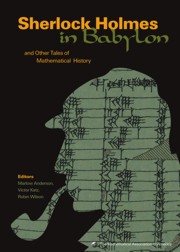Book contents
- Frontmatter
- Introduction
- Contents
- Ancient Mathematics
- Medieval and Renaissance Mathematics
- Foreword
- The Discovery of the Series Formula for π by Leibniz, Gregory and Nilakantha
- Ideas of Calculus in Islam and India
- Was Calculus Invented in India?
- An Early Iterative Method for the Determination of sin 1°
- Leonardo of Pisa and his Liber Quadratorum
- The Algorists vs. the Abacists: An Ancient Controversy on the Use of Calculators
- Sidelights on the Cardan-Tartaglia Controversy
- Reading Bombelli's χ-purgated Algebra
- The First Work on Mathematics Printed in the New World
- Afterword
- The Seventeenth Century
- The Eighteenth Century
- Index
- About the Editors
The First Work on Mathematics Printed in the New World
from Medieval and Renaissance Mathematics
- Frontmatter
- Introduction
- Contents
- Ancient Mathematics
- Medieval and Renaissance Mathematics
- Foreword
- The Discovery of the Series Formula for π by Leibniz, Gregory and Nilakantha
- Ideas of Calculus in Islam and India
- Was Calculus Invented in India?
- An Early Iterative Method for the Determination of sin 1°
- Leonardo of Pisa and his Liber Quadratorum
- The Algorists vs. the Abacists: An Ancient Controversy on the Use of Calculators
- Sidelights on the Cardan-Tartaglia Controversy
- Reading Bombelli's χ-purgated Algebra
- The First Work on Mathematics Printed in the New World
- Afterword
- The Seventeenth Century
- The Eighteenth Century
- Index
- About the Editors
Summary
General description
If the student of the history of education were asked to name the earliest work on mathematics published by an American press, he might, after a little investigation, mention the anonymous arithmetic that was printed in Boston in the year 1729. It is now known that this was the work of Isaac Greenwood who held for some years the chair of mathematics in what was then Harvard College. If he should search the records still further back, he might come upon the American reprint of Hodder's well-known English arithmetic, the first textbook on the subject, so far as known, to appear in our language on this side of the Atlantic. If he should look to the early Puritans in New England for books of a mathematical nature, or to the Dutch settlers in New Amsterdam, he would look in vain; for, so far as known, all the colonists in what is now the United States were content to depend upon European textbooks to supply the needs of the relatively few schools that they maintained in the seventeenth century.
The earliest mathematical work to appear in the New World, however, antedated Hodder and Greenwood by more than a century and a half. It was published long before the Puritans had any idea of migrating to another continent, and fifty years before Henry Hudson discovered the river that bears his name.
- Type
- Chapter
- Information
- Sherlock Holmes in BabylonAnd Other Tales of Mathematical History, pp. 169 - 172Publisher: Mathematical Association of AmericaPrint publication year: 2003



